
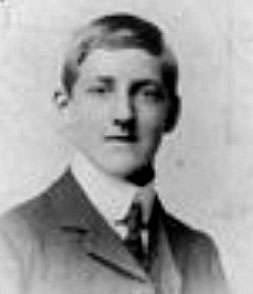

Research has shown that the majority of Ossett men who served in WW1 were Private soldiers and whilst more than a few advanced to become N.C.O.s, Corporal and Sergeant rank, very few Ossett men were Commissioned Officers in the WW1 Armed Forces. Eli Townend Archer and George Edward Jessop were the only Commissioned Officers, Lieutenants, of 302 Ossett men who died in service during WW1. Both were from Ossett mill owning families.
However, one extraordinary family who lived in Ossett, the Digges La Touche family, had two sons who were commissioned officers. One son, John James, known as Jack, born in 1892, served with the R.A.M.C. from August 1914 and the other son, Alexander Arthur, born in December 1899, became a Navy Cadet in 1912 and was still a cadet at Dartmouth on the day WW1 began in 1914. He entered the Royal Naval Service a year or so later at the age of 16 years. One of their two sisters, Mary, was married at Ossett Holy Trinity Church to William Reginald Balden of Dewsbury, the son of the Borough’s Lord Mayor, who served in the fledging Royal Air Force towards the end of the WW1. Mary and her husband lost both of their teenage sons in WW2.
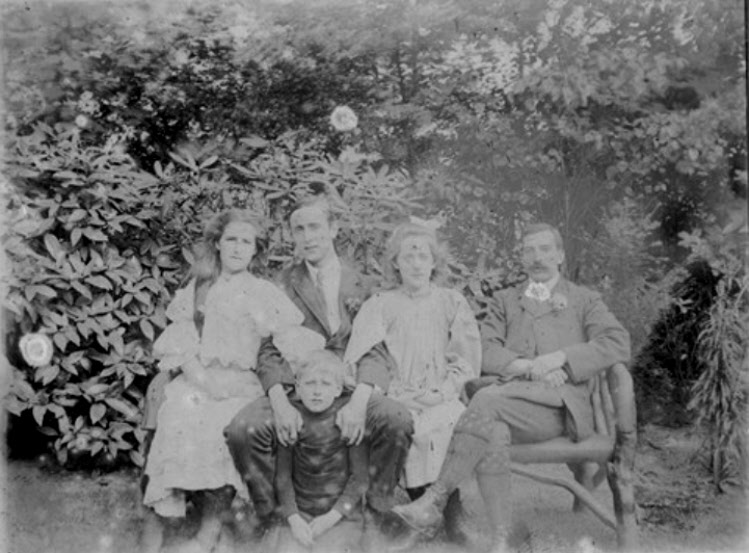
Above: The Digges La Touche family. Mary (born 1893), John James (1892), Gertrude (1895), with their father Alexander (1859). In front is Alexander junior (born 1899).
The Digges (Digues) La Touche family can be traced back to aristocratic roots in 16th century France. In the 17th century, David Digues La Touche left France for Holland to escape persecution after refusing to renounce his Huguenot protestant faith. There he joined the army being recruited by William of Orange to fight in Ireland where he fought at the Battle of the Boyne. After the war he settled in Dublin where he established a weaving business.
Because of his apparent honesty and integrity, fellow Huguenots began to trust him with their surplus cash. Over time this side of his business developed into a bank, becoming the leading private bank in Ireland. The bank’s fortunes waned in the nineteenth century, and it was taken over by the Munster Bank in 1870. When the Bank of Ireland was established in 1783 David’s grandson, also David, became the first governor.
Alexander Digges La Touche was born in Sri Lanka in 1859, the son of Edmund Digges La Touche, a civil engineer, who died young in Tasmania in 1864. Alexander qualified as a physician in Ireland in 1884 and was appointed surgeon to the British and African Steam Navigation Company and was in practice as a surgeon in Benin, West Africa. He qualified as a surgeon in Edinburgh in 1888 and established his practice in Ossett in the same year. Alexander’s eldest son, John James, was recorded in Ossett in 1935, indicating that the family had been present in Ossett for almost fifty years.
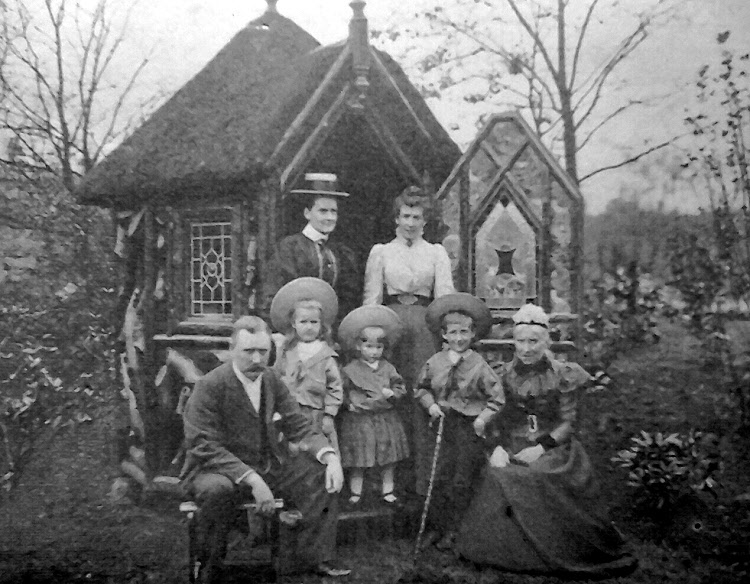
Above: The Digges La Touche family. Mary (born 1893), John James (1892), Gertrude (1895), with their father Alexander (1859). In front is Alexander junior (born 1899).
The Digges (Digues) La Touche family can be traced back to aristocratic roots in 16th century France. In the 17th century, David Digues La Touche left France for Holland to escape persecution after refusing to renounce his Huguenot protestant faith. There he joined the army being recruited by William of Orange to fight in Ireland where he fought at the Battle of the Boyne. After the war he settled in Dublin where he established a weaving business.
Because of his apparent honesty and integrity, fellow Huguenots began to trust him with their surplus cash. Over time this side of his business developed into a bank, becoming the leading private bank in Ireland. The bank’s fortunes waned in the nineteenth century, and it was taken over by the Munster Bank in 1870. When the Bank of Ireland was established in 1783 David’s grandson, also David, became the first governor.
Alexander Digges La Touche was born in Sri Lanka in 1859, the son of Edmund Digges La Touche, a civil engineer, who died young in Tasmania in 1864. Alexander qualified as a physician in Ireland in 1884 and was appointed surgeon to the British and African Steam Navigation Company and was in practice as a surgeon in Benin, West Africa. He qualified as a surgeon in Edinburgh in 1888 and established his practice in Ossett in the same year. Alexander’s eldest son, John James, was recorded in Ossett in 1935, indicating that the family had been present in Ossett for almost fifty years.

Above: Station Road in the early 1900s. The Digges La Touche Doctors’ home and Surgery is far right with a gable front.
In 1911, the ten-roomed household was much the same with the exception of Dr Alexander Digges La Touche’s mother, Jane, who died in 1909 and the two nieces who were elsewhere. John James was a medical student, aged 18, and the other three children, including Alexander Arthur, were at school. Around this time, 1912-1913, Alexander bought his first car, a German made Metallurgic.
John James (“Jack”) Digges La Touche, Captain, R.A.M.C.
John James’ army service record has not been located, but it is known that he served as Capt., M.B., R.A.M.C. Spec. Res. Medical Services and that he was gazetted on 7th March 1918 when he was “Mentioned in Despatches.” This indicates that his name appeared in an official report, written by a superior officer and sent to the high command, describing the soldier’s gallant or meritorious action in the face of the enemy.
John James was a medical student in 1911 and gained his M.B., Bachelor of Medicine, and a Ch.B. at the University of Leeds in 1914.
The London Gazette dated the 1st September 1914 reported that:
“ROYAL ARMY MEDICAL CORPS
The undermentioned cadets and ex cadets of the Officers Training Corps to be Lieutenants (on probation)……Dated 7th August 1914…John James Digges La Touche.”
John James embarked for West Africa on the 21st February 1915. At some stage he was attached to the King’s African Rifles (K.A.R.). He was awarded the British and Victory medals and, to recognise his service overseas before the 31st December 1915, the 1914/15 Star. This latter award was made with an oak leaf emblem which was awarded for those who were mentioned in despatches. His medal card confirms that he began his army service as a Lieutenant, but was subsequently promoted to Captain.
The British and French invasion of the German Colony of Togoland in West Africa began on the 7th August 1914 and ended with the surrender of the colony on 26th August 1914. This early action was followed by the Kamerun campaign in which the enemy provided much more resistance in defence of their colony (Cameroon). The British forces suffered significant setbacks in 1914 and into Spring 1915 the German forces repulsed the British attacks. The Battle of Gurin, near the border of German Kamerun and British Nigeria may have been John James first experience of battle when the German forays were successfully repulsed. The British and French had more success later in the West African campaigns and by early 1916 most of the action in the region had ended.
At some stage John James, still in the RAMC, was attached to the Kings African Rifles (K.A.R.). This was a British regiment raised from British colonies and possessions in East Africa. The full strength of the K.A.R. in 1914 was 70 British officers, three British NCOs, and 2,325 Africans. There were no organic heavy weapons (each company had only one machine gun), including artillery or organised reserves and the companies were in reality large platoons of 70 to 80 men.
Soldiers (other ranks) of the King’s African Rifles were recruited from Somaliland, British East Africa (Kenya from July 1920), Uganda, Nyasaland, and following its transfer to the British after World War I Tanganyika (previously German East Africa). Officers were seconded from the British Army (rather than a permanent commission to the force)
The KAR saw action in Somaliland against Hajj Muhammad bin Abdullah Hassan, known to the British as the Mad Mullah, and during World War One against the forces of Paul Erich von Lettow-Vorbeck in East Africa. By the end of World War One, the KAR consisted of 22 battalions, 1,193 British officers, 1,497 British NCOs and 30,658 Africans. http://www.colonialfilm.org.uk/node/6218
The King’s African Rifles had been in existence since 1901. Originally it was made up of three battalions but new recruits were added from the East African Protectorate (now Kenya), Uganda, Nyasaland (now Malawi), Northern Rhodesia (now Zambia) and Zanzibar. They fought throughout the East African campaign. By 1918 nearly 32,000 African soldiers had fought in the King’s African Rifles. Of these nearly 4,000 had died.
Although much of the fighting on this continent took place in East Africa, colonies in both East and West Africa contributed money and produce to the Allied war effort. The East African Campaign lasted from August 1914 right through to November 1918. By the end of 1916 British troops fighting in East Africa were made up of a great mixture of nationalities and included the Gold Coast Regiment, the King’s African Rifles, white South African troops and three regiments from India.
But John James Digges La Touche (pictured right) was a medic and even though he was attached to the KAR he remained a Captain in the RAMC. This was not a fighting force, but its members saw the full horror of war. Warrant Officers and men performed their duties unarmed and the Corps lost themselves no less than 6,873 personnel during WW1; of these an estimated 470 officers and 3,669 other ranks were either killed in action or died of wounds. Throughout the war RAMC personnel were praised over and over again in despatches and by 1929 the Corps could proudly boast ownership of many foreign orders and various foreign medals.
Since John James was mentioned in despatches and gazetted in March 1918, when his medal card records that he was attached to the KAR, it seems probable that he served in the RAMC for the full duration of 1914-1918.
John James Digges La Touche was demobilised probably shortly after November 1918, and two years later on the 24th November 1920, he married 28 year-old spinster Violet Constance Willey at the Christ Church, High Harrogate. John James’ occupation on the registration was Doctor and his address was Ossett, Yorkshire. His mother, Sarah, was one of the witnesses to the marriage. The couple had three children, Denis La Touche (born 1921), Peter D. La Touche, (1922 -1922) and Richard J. La Touche, (1925- 2015). All of the births were registered in Dewsbury, suggesting that they were probably born In Ossett. Denis became a G.P. like his father and Richard became an architect.
The 1923 Telephone Directory provides numbers for John James’s father and himself as follows: A.D. La Touche, Physician & Surgeon, Prospect House, Ossett (telephone Ossett 113), J.J.D. La Touche, Physician & Surgeon, Thornfield House, Ossett (telephone Ossett 10) and La Touche & La Touche, Physicians & Surgeons Leeds Road Ossett (telephone Ossett 139) and Highfield Road, Horbury (telephone Horbury 31).
By 1929 John James had moved to Prospect House. Alexander had retired from the practice in Ossett in the same year and moved to live at Park Drive in Harrogate, where he died in 1943. Their joint practices at Leeds Road, Ossett and Highfield Road, Horbury were now known as “La Touche and Newall.” John James left the practice in Ossett in about 1935, and moved to live in a newly-constructed house, Greystones, Alwoodley, on the northern outskirts of Leeds. By September 1939, at the outbreak of WW2, John James was still living at “Greystones”, Alwoodley Lane, Leeds.
John James served again in the RAMC during WW2, mostly stationed in India. Retired after the war, he and his wife Violet moved to a smaller house designed by his architect son Richard, but still in Alwoodley. By 1959 he was living at “Thornfield”, Harrogate Road, Leeds and this was his address at the date of his death on the 19th January 1965. John James Digges La Touche died at The General Infirmary, Leeds and probate of his estate was granted at London on the 26th March to Violet Constance Digges La Touche, widow; Denis Digges La Touche, medical practitioner and Richard John Digges La Touche, architect. His estate was worth £44,395.
Alexander Arthur Digges La Touche, Lieutenant Commander, Royal Navy was 18 years old when the Armistice was signed on the 11th November 1918. He was awarded the British and Victory medals and, remarkably, the 1914/15 Star, indicating that he served on board ship in a Theatre of War on or before the 31st December 1915, which coincidentally, was his 16th birthday. His medal record indicates that his awards were made at “Dolphin”, which by that time, was the name of the shore establishment for the submarine service at Gosport.
Alexander Arthur (pictured left) entered the Royal Naval College, Osborne in 1911 and transferred to Dartmouth in 1913, where he spent a further two years. His Navy service record has survived and records his birth as the 31st December 1899 and his entry to service in September 1912 (when he was 12 years old). He boarded the battleship “H.M.S. Colossus” on the 1st July 1915 (aged 15 years), going to sea as a midshipman. He was aboard the “Colossus” at the Battle of Jutland in 1916, during which a small fragment of shrapnel pierced his cap, luckily missing his head. He was subsequently made Acting Sub-Lieutenant on 15th September 1917 and Sub-Lieutenant on the 15th May 1918.
He served aboard “H.M.S. Colossus” until March 1918 when he moved to the Victory and, subsequently, the Dolphin shore bases in Portsmouth and Gosport respectively. After the war he served for a time in submarines. In 1919, whilst still serving in the Royal Navy he attended Cambridge University between October 1919 and April 1920, where he gained an honourable mention in Chemistry, Mathematics, Physics and Marine Engineering. He returned to Cambridge later in the 1920s when he gained his B.Ch.
He was made Lieutenant on the 15th August 1919 but it appears that Alexander and the Royal Navy were coming to the conclusion that his considerable theoretical and technical qualities would be better employed on shore in experimental technology than off shore, commanding men aboard ship or submarine. He volunteered for training as an R.A.F. Observer in November 1921 and he was placed on the Navy Retired List on the 15th August 1922. This was at a time when the size of the navy was drastically reduced in accordance with an international treaty. This was termed “Geddes’ Axe”, after the government minister involved.
Alexander Arthur was transferred to the naval retired, or possibly reserve, list and decided to take up medicine like his father and brother. He returned to Cambridge, studied for his BCh degree, which he gained in two years, and then completed his training at the Leeds General Infirmary. His service record does not reflect his subsequent undergraduate course at Cambridge, and in 1927 he was appointed Lieutenant-Commander (Ret’d).
The 1944 Navy List records that on the 15th June 1927, Alexander Arthur Digges La Touche M.A., M.B., B.Ch., F.R.C.S., D.M.R. [M] was appointed a Lieutenant-Commander. Later that Summer, Alexander married Joan Cotton Marshall at Slapton, Kingsbridge, Devon. Initially they lived in Clarendon Road, Leeds, while Alexander Arthur pursued his medical career at the Leeds General Infirmary. In 1929, the Royal Navy granted permission for him to accept an appointment as Assistant Medical Officer at Leeds General Infirmary. In 1931 after their son, Michael, was born, they moved to a house, “Whitegates”, in Pool-in-Wharfedale, to the north of Leeds. During the 1930s Alexander Arthur set up the Radium Department at the Infirmary, becoming its first Director.
By way of recreation Alexander Arthur took up flying, bought a Gipsy Moth biplane and gained his pilot’s licence. His wife, Joan, also obtained her pilot’s licence. During the 1930s they made many flights, both locally and as far afield as Hungary. On the 9th January 1932, at the base of the Yorkshire Aeroplane Company, Alexander, Medical Practitioner born in Ossett, flew a Moth 85 H.P. Cirrus to gain his Royal Aero Club Aviator Certificate.
On the 19th August 1939, Alexander, who, like others of his rank, remained on the “retired list”, served in the Royal Navy in WW2. In August 1939 Alexander Arthur was recalled to the naval service, but as an executive officer, not as a doctor. His record refers to “pool of officers Columbo” which was the R.N. base in Sri Lanka (Ceylon) and initially, he was sent out to there but soon returned, spending most of the rest of war ashore in Portsmouth attached to “HMS Vernon”, but working at a commandeered garage site in Southsea. He and Joan rented a flat with a sea view in Southsea.
Following the enemy bombing of Portsmouth Harbour in August 1940 the shore based training establishment was dispersed to other sites around the country. One such location for HMS Vernon was the land based H.Q and Central Administration Centre and the Admiralty Torpedo, Mining & Electrical Training Establishment based at Roedean School for Girls, Brighton, between May 1941 and June 1945.
It has passed into naval lore that before the Navy moved into the school the Captain insisted that all of the female pupils should leave; it was rumoured that some of the sixth formers were still in residence. The mistress in charge, reportedly replied “my girls will be all right; they’ve got it up there” whilst tapping her head, to which the Captain answered “Madam, it matters not where your girls have it, rest assured my soldiers will find it!” This makes for a good yarn, but is of course fiction, as dates prove. http://www.royalnavyresearcharchive.org.uk/Vernon_1.htm
Alexander was dispersed on 15th November 1945, released on 10th January 1946 and reverted to the retired list the following day having served his country in two wars. V-E Day was 8th May 1945 and V-J Day was 2nd September 1945.
After the war ended Alexander Arthur returned to Leeds and resumed his post at the Infirmary. He and Joan established their home at 21, Alwoodley Gardens, Leeds and Alexander was recorded at that address in 1956. The Radium Department of the L.G.I. became the Radiotherapy Department. Alexander Arthur retired in 1957 and moved to live at St Raphael in the South of France. Alexander Arthur Digges La Touche Lt Commander R.N. died there on the 14th January 1981, aged 81 years.
A member of The Royal College of Surgeons the biographical entry for Alexander Arthur in “Plarr’s Lives of Fellows Online” appears as follows:-
“Alexander Digges La Touche, the son of a general practitioner, was born at Ossett, Yorkshire, on 31 December 1899. On leaving Queen Elizabeth Grammar School, Wakefield, he entered the Royal Naval Colleges at Osborne and Dartmouth before serving as an Executive Officer in the Royal Navy during the first world war. He retired as a Lieutenant RN in 1922 and became an undergraduate at Emmanuel College, Cambridge, before proceeding to Leeds for his clinical training. After taking the final Conjoint examination he was house surgeon and resident gynaecological officer at the General Infirmary, Leeds, and later assistant medical officer to the department of venereology. He then decided to take up radiotherapy and completed his Cambridge degrees after passing the DMR examination. He subsequently became director of the radiotherapy department at the General Infirmary, Leeds, and senior lecturer in radiotherapy at Leeds University. During the second world war he served in the medical division of the Royal Navy and was demobilised with the rank of Lieutenant-Commander.
Digges La Touche was a keen skier, swimmer and arachnologist and held a private pilot’s licence. He died on 14 January 1981 and was survived by his wife, Joan Cotton Marshall, whom he married in 1927 and they had one son.
Sources used to compile this entry: [Daily Telegraph 19 January 1981]”.
In all respects but one, Plarr’s biographical entry is correct. The error is that the entry refers to Alexander serving in WW2 in the medical division of the Royal Navy. Alexander Arthur did indeed serve in the Royal Navy in WW2 but he did not serve in the medical division.
The story of the Digges La Touche family and their involvement in matters to do with WW1 (and WW2) would not be complete without some comment about Alexander and Mary’s second child and elder daughter, Mary.
Mary Digges La Touche was born in Ossett on the 21st September 1893 and later baptised at Ossett Holy Trinity Church. She married William Reginald “Rex” Balden at the same Church on the 30th November 1921.
The wedding was acclaimed throughout the district as one of the social events of the year and interest aroused was so great that police had to restrain enthusiastic spectators who lined the thickly carpeted walks outside the Church. Reports of the time also indicate that it was necessary to ask many spectators to leave the Church to allow access for the marriage party.
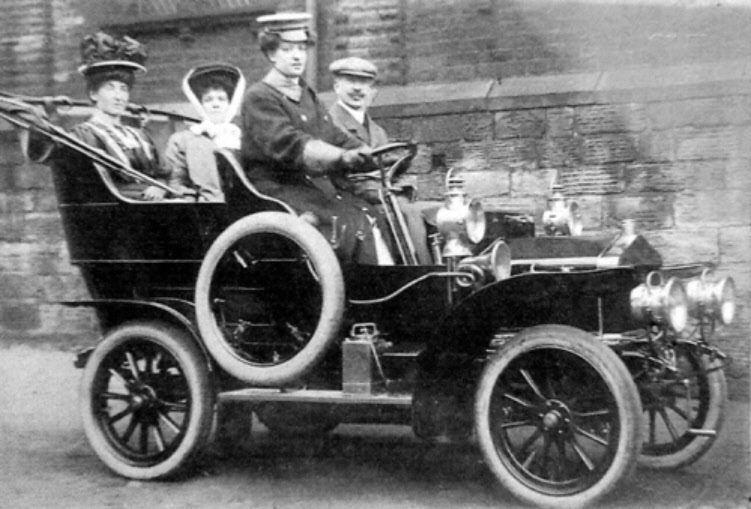
Above: Mary Digges La Touche at the wheel about 1915 (Photograph courtesy of Michael La Touche)
During WW1 Mary made her own contribution to the war effort by acting as her father’s driver on his visits to his sick patients. She acted thus in the stead of his usual driver and her two brothers who were all overseas serving in the armed forces. She claimed to be the first woman in Ossett who was able to drive.
The couple subsequently lived at Bywell House, Leeds Road, Dewsbury and Mary went on to establish the Dewsbury branch of the St. John Ambulance Service and became Area Cadet Officer for the Service.
Mary’s husband, Rex Balden, was born in Dewsbury in July 1892, the son of Dewsbury Alderman and at the time of their marriage, the mayor of Dewsbury. Rex volunteered for service in WW1 and joined the 21st Battalion Royal Fusiliers (City of London) Regiment at the rank of private and embarked for France on the 14th November 1915. He gained a commission with the Royal Flying Corps (9 Squadron), later the Royal Air Force, on the 4th September 1916. By the 8th December 1916, he was a 2nd Lieutenant in the R.F.C. and gained his Royal Aero Club Aviator’s Certificate, which he took in a Graham-White Biplane at the eponymous Flying School in Hendon. He subsequently achieved the rank of Captain serving until the conclusion of WW1.
On the 16th April 1917 he was flying in a BE2c 7163 plane when he was shot down and wounded by ground fire. He managed to land behind British lines. After the War he helped to found the 96th Dewsbury Squadron Air Training Corps of which his eldest son was a member.
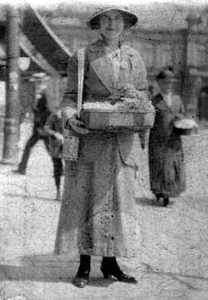 Mary and Rex had three children, one daughter and two sons, born between 1923 and 1927, who all served in the armed forces in WW2
Mary and Rex had three children, one daughter and two sons, born between 1923 and 1927, who all served in the armed forces in WW2
Margaret Julia (Judie) was the eldest child, born in 1923 and she served in the Women’s Auxiliary Air Force (W.A.A.F.) She was also one of the first eight civilian women to take up Ground Control Approach at London airport.
Robert Alexander (Robin) was born in March 1925, joined the R.A.F. in 1943 and was killed in Canada in October 1944, aged 19 years, in a flying accident whilst serving as a cadet pilot with the RAF. He was a passenger in the aeroplane at the time.
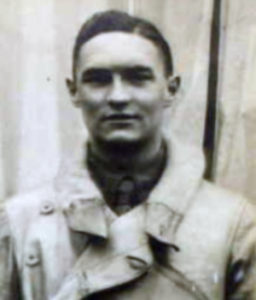 William Digges La Touche Balden (Billy) was the youngest child, born in Dewsbury in August 1927. William joined the HMS Conway Training Ship at the age of 14 years in 1941. In August 1945, after being engaged in convoys to South Africa, America and Canada, he was serving as a Midshipman in the Merchant Navy on a Blue Funnel vessel, a British Victory ship, berthed at Geelong, Australia. He and three senior officers were cleaning a ballast tank aboard when they were overcome by overcome by carbon monoxide fumes and were suffocated. William died five days before his 18th birthday.
William Digges La Touche Balden (Billy) was the youngest child, born in Dewsbury in August 1927. William joined the HMS Conway Training Ship at the age of 14 years in 1941. In August 1945, after being engaged in convoys to South Africa, America and Canada, he was serving as a Midshipman in the Merchant Navy on a Blue Funnel vessel, a British Victory ship, berthed at Geelong, Australia. He and three senior officers were cleaning a ballast tank aboard when they were overcome by overcome by carbon monoxide fumes and were suffocated. William died five days before his 18th birthday.
Rex Balden died in Northumberland in late 1981 and his wife Mary (nee Digges La Touche) died in Northumberland in the following Spring.
I am extremely grateful to Michael La Touche who, in April 2016, submitted additional information about his father, grandfather and other members of his De La Touche family. This is now incorporated into the above biography of his remarkable family.